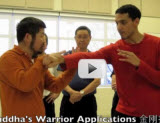My name is Ramona. I started practicing Practical Method Tai Chi with Ping Wei approximately one year ago at Paradise Valley Community College. I have always liked martial arts and was curious about Tai Chi. The promise of strength, balance, and brain power intrigued me so I decided to give it a try. After all, what can I lose? After a year of steady practice I have improved, or so my teacher tells me, and he should know. After all he has been practicing for many years.

Strength
I am plagued by weak knees. I was a runner and I injured my left knee requiring surgery. I was advised to stop running and so I did. I took up hiking and backpacking about five years ago to help strengthen my legs and knees. My orthopedic doctor advises me to get a knee replacement since I have arthritic knee joints, but I think it may make me worse. I do not want to jeopardize my hiking hobby with a surgery that may or may not make me better, so I decided to do Tai Chi.
When I started Tai Chi my knees tended to fall inwards toward each other. As I listened to Ping to ‘keep good alignment’ I noticed my knees started to be stronger. The muscles of my quads are noticeably stronger. I no longer wear knee brace for my long distance backpacking trips. My knee joints still get sore occasionally, but the arthritis will always be there. However the muscles and tendons around the knees are stronger making me more confident on the trails and my hikes more enjoyable.
Balance
Balance is dependent on body awareness and where your body is in space at every moment. In Tai Chi practice, you think about where each part of your body is in relation to the other parts and how the parts move together. As Ping says, ‘The body is like gears moving together.’ Getting to know you own body is harder than it seems. After all, most of us just move through our daily lives with little regard to how the body is moving. As we age our bones can become more brittle if we do not engage in weight bearing exercise. We can do this by using our own body weight to keep our center balanced. Keeping knees bent with the weight in the center is one of the easiest weight bearing exercises that can be done anywhere without any equipment. This can teach us balance.
Brain Power
Learning the choreography of the Practical Method is not very difficult. In my personal experience, I am not good at memorizing choreography, so it is somewhat difficult for me and taking me a long time. I also tend to be a perfectionist, so if I cannot get a certain form correct, it seems I am stuck there until I can get it right. Staying focused is the key here. Do not get so distracted by others practicing with you. Practice a little on your own every day. Getting the form correct gives a great sense of accomplishment and pride. Once the form is learned, then you must move beyond and focus on the small details that will make the practice better and better. I don’t think you will ever achieve ‘perfection’ as there will always be improvements to be made. This is why it is called a ‘practice’, right?
In conclusion, what I have learned in the past year is how to move better physically. The first few times I practiced I thought I would never learn the form, it seemed so complicated. I still do not know it all, but I am confident that I will know it eventually. There is no pressure to be better than anyone else or to achieve perfection. The only pressure is to be better than you were yesterday.



{ 1 comment… read it below or add one }
Ramona, thanks for sharing. Your comment about never achieving perfection reminds me of a comment Master Chen made in one of his videos, but I can’t remember which one. He says something to the effect that if there are 9 points to line up, we will never be able to get all 9, but if you can line up 3 and I can line up more, then I win.
So we should practice to get at least one more.